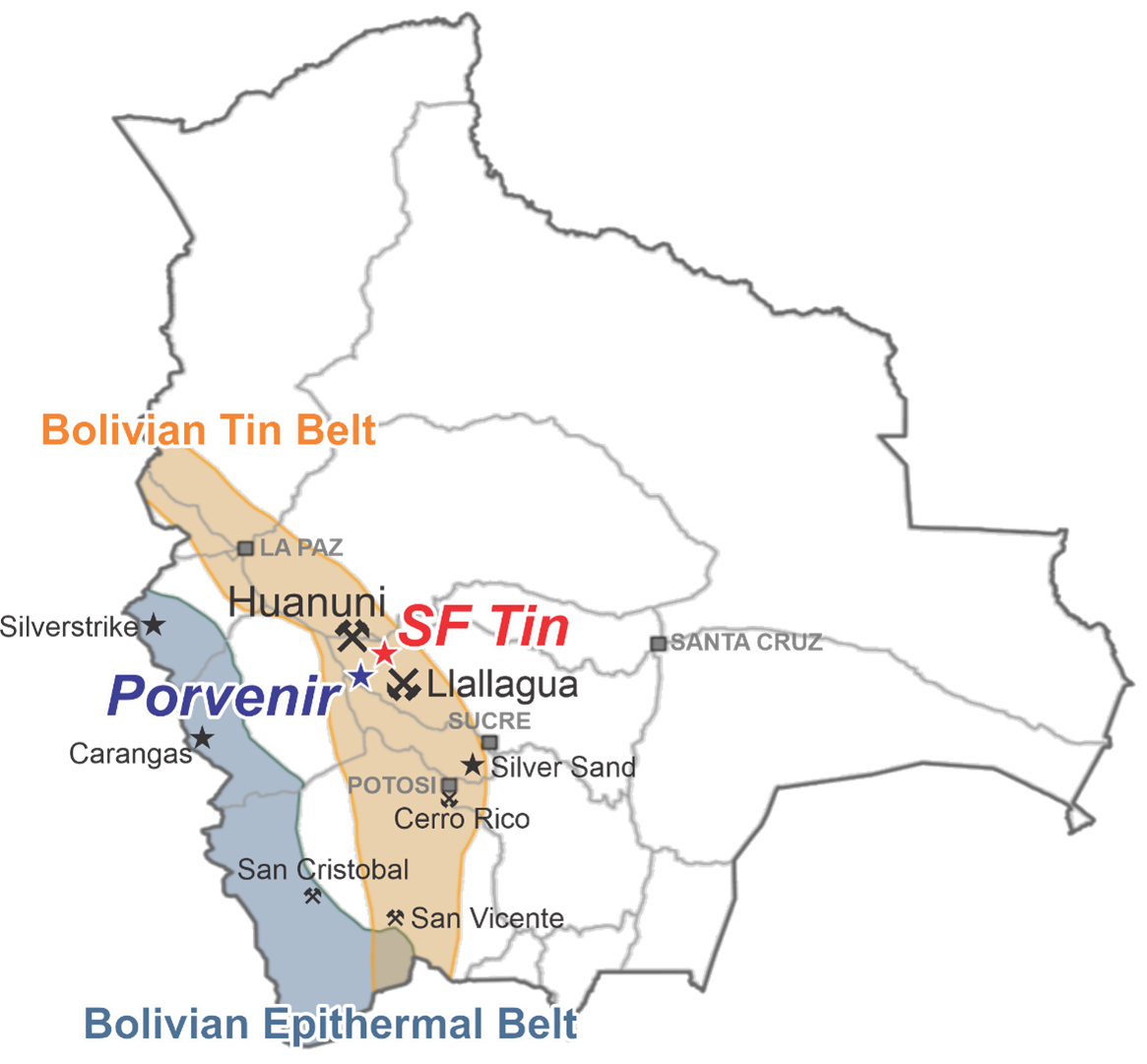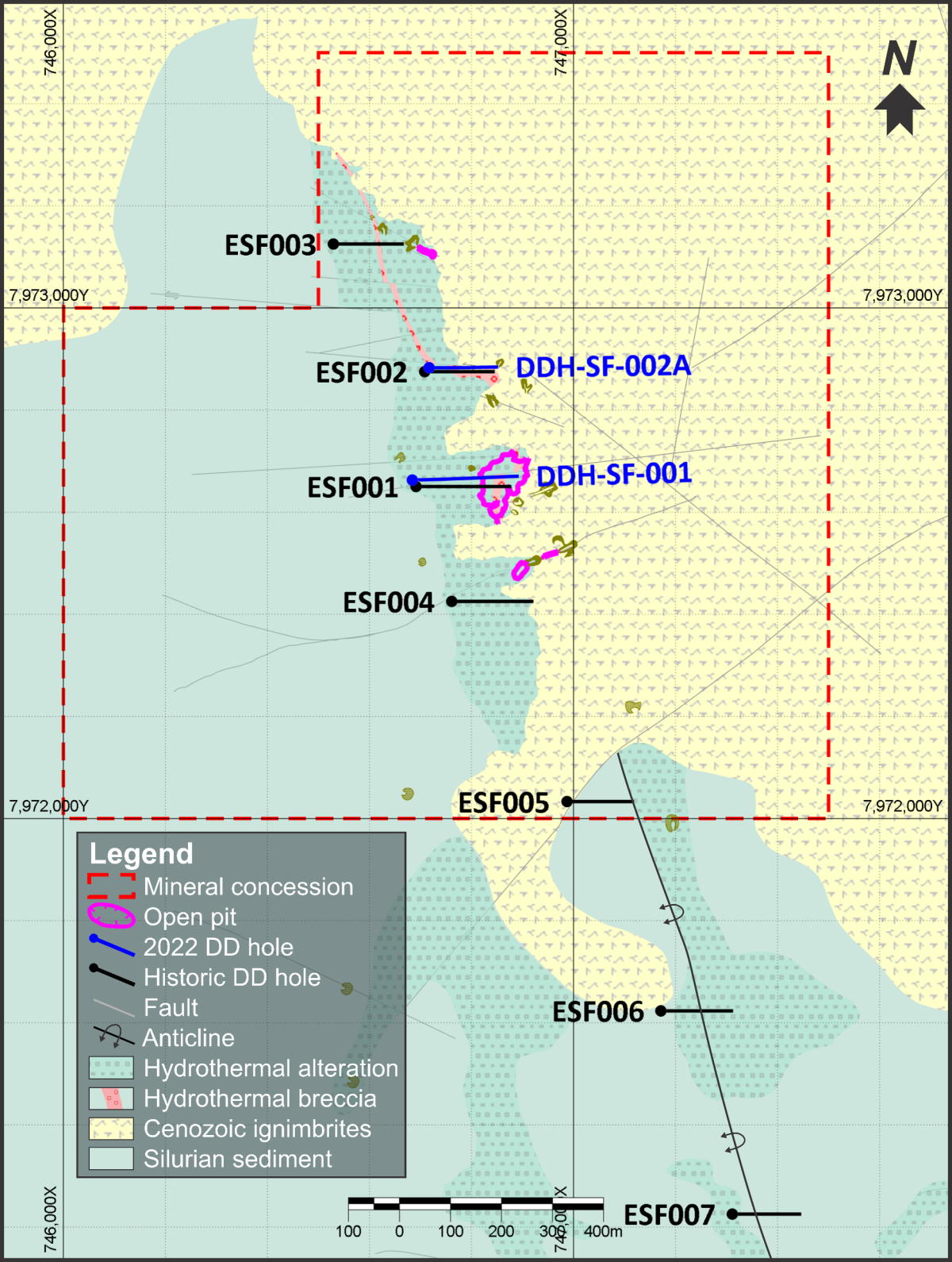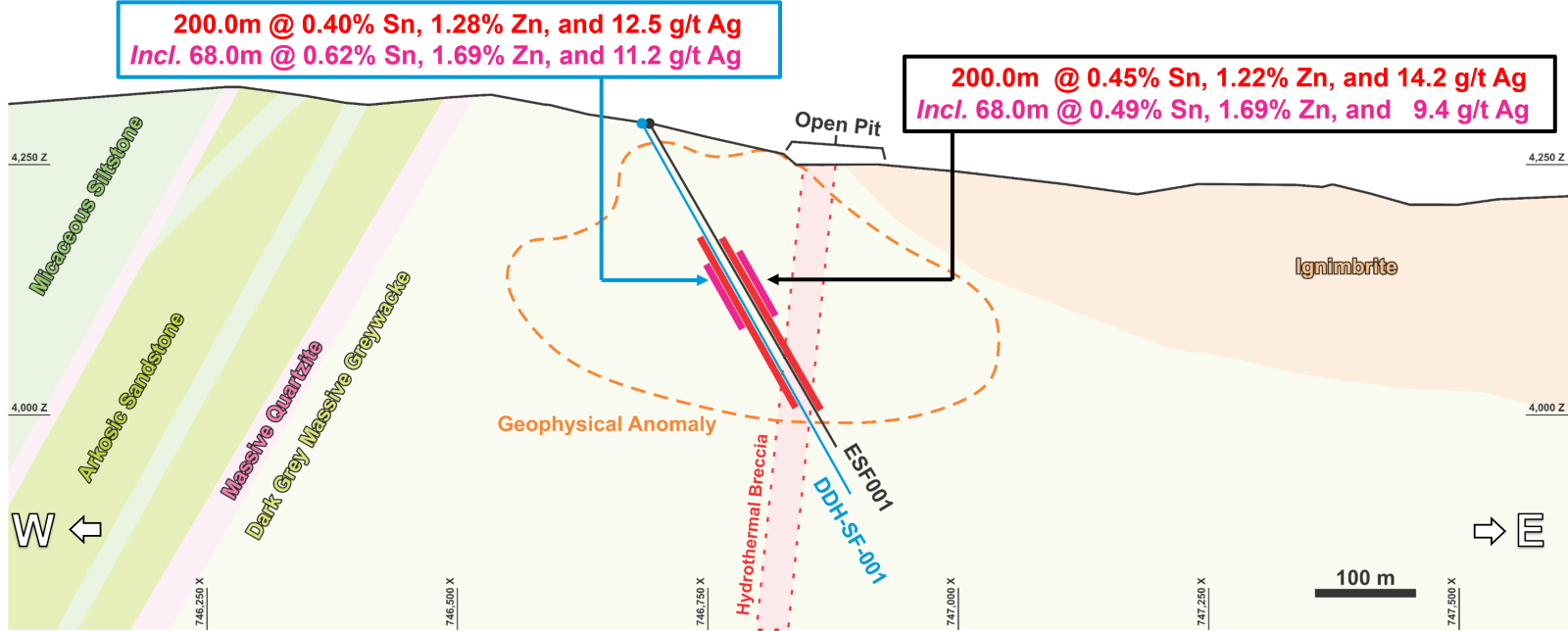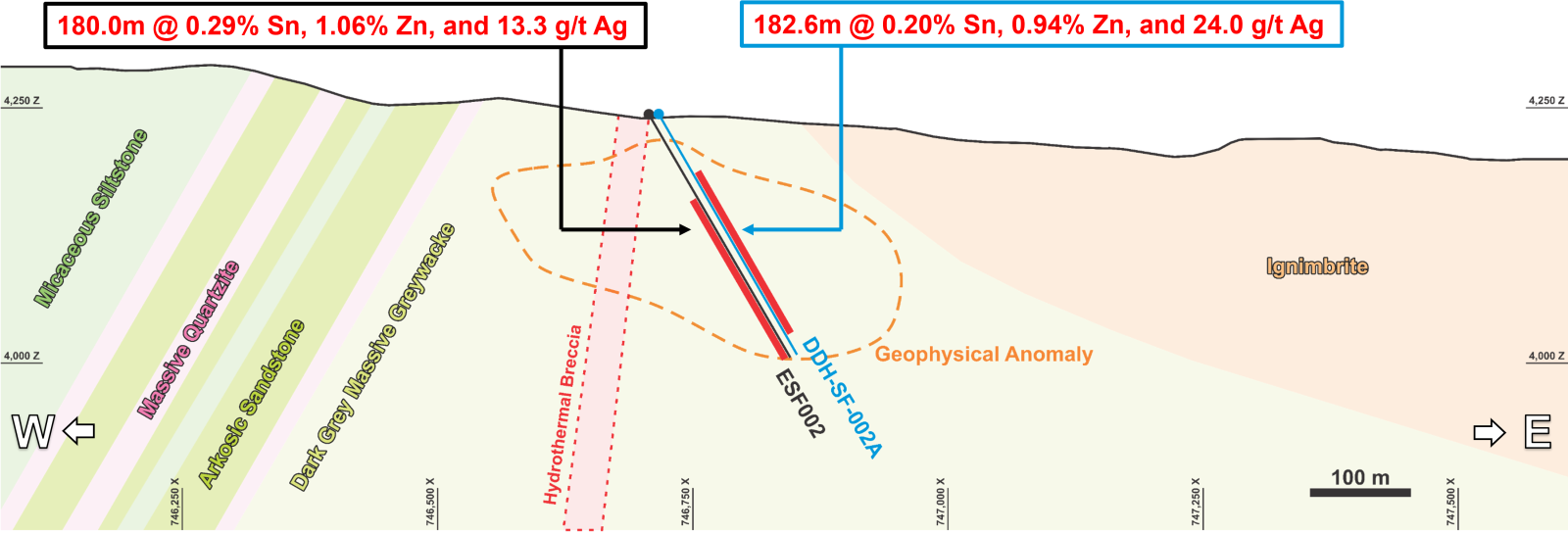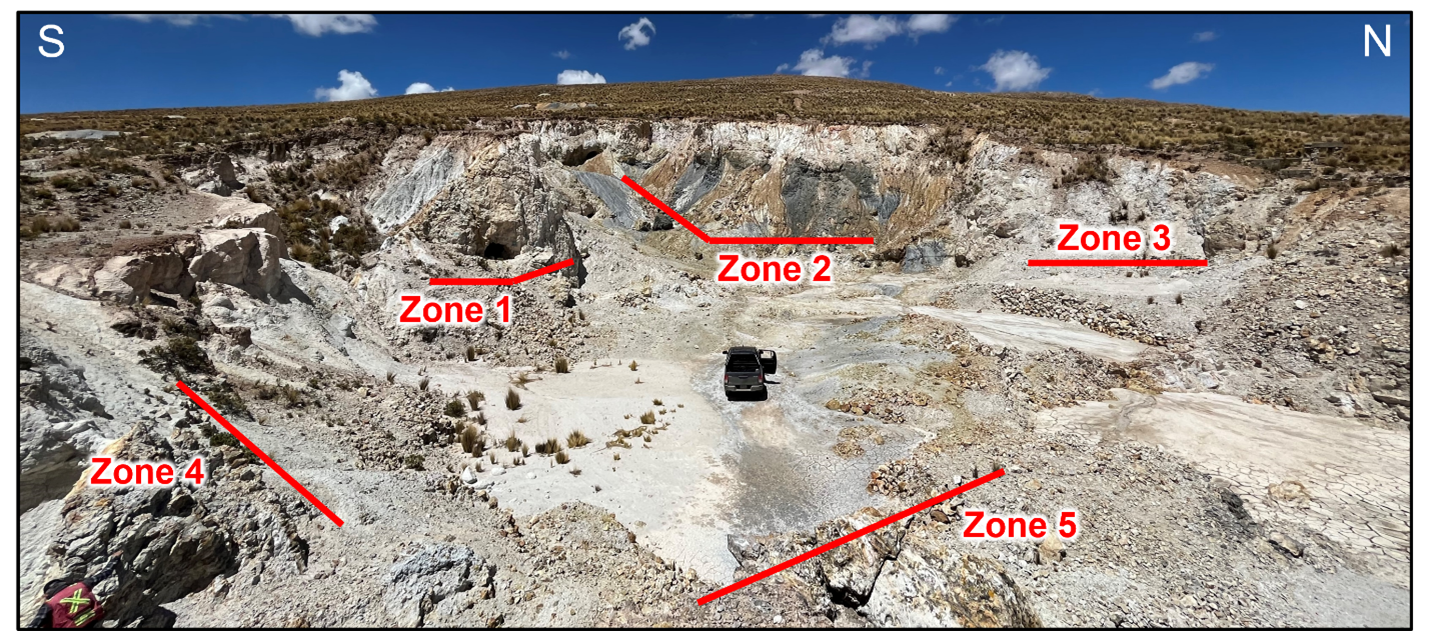Overview
At an elevation of 4,200m, the SF Tin Project permit (AMC) covers an area of approximately 2 km2 in the Potosi department of Bolivia. The project is accessed by 72 km paved road from Oruro city, followed by a 5 km gravel road, and it is only 15 km north-west to the Llallagua deposit, one of the world’s largest tin deposits (Figure 1).
Figure 1: Location of the SF Tin project.
The property encompasses a historical open pit (100m by 100m by 20m) and numerous underground workings from Spanish Colonial times, showing the deposit was subjected to small-scale mining. Abandoned small-scale grinding and gravity separation mills for ore treating are located by the pit.
In the 1990s, Rio Tinto conducted an exploration program on the project, which involved numerous exploration trenches and a drilling program consisting of 7 diamond drill holes (5 within the SF Tin Project AMC permit, Figure 2). Among these holes, drill hole ESF001 intercepted a 200.0m interval grading 0.45% Sn, 1.22% Zn and 14.1 g/t Ag (Figure 3), and drill hole ESF002 intercepted a 180.0m interval grading 0.29% Sn, 1.06% Zn and 13.30 g/t Ag (Figure 4).
Figure 2: Geological map of the SF Tin project
Geology
The San Florencio project is located in the Eastern Cordillera of Bolivia; aligned on a main structure (Llallagua anticline), to the south of the Morococala volcanic field.
The mineralization is hosted within a window of Silurian age (423 – 419 Ma) diamictite comprising interbedded and layered units of greywacke, as well as interbedded sandstone, siltstone, and shale units. In the north portion of the project, the Silurian-aged sedimentary rocks which host the mineralization are unconformably overlain by volcano-sedimentary and pyroclastic ignimbrites of the Cenozoic age, with dacitic to rhyodacitic compositions across much of the surrounding area (Figure 2).
The mineralization appears to be structurally controlled along an NW to NNW trending zone, which comprises a stockwork framework formed by a series of mineralized stringers, less than 1cm wide, as well as sulfide veins which range in thickness from 1 to 30cm, slightly dipping west. Mineralized hydrothermal breccias, ranging in thickness from 1cm to 30m are also observed in the diamictite, with disseminated sulfides occurring within the matrix and clasts of the breccia, as well as cross-cutting mineralized stringers. The sulfide minerals in the project are mainly pyrite and sphalerite. Mineralization of cassiterite is highly associated with sphalerite but is not macroscopically visible.
Tincorp Exploration Program
In 2022, Tincorp twinned ESF001 (DDH-SF-001) and ESF002 (DDH-SF-002A) in 15m spacing to confirm the historical assay results (Figure 3 & 4) and channel sampled five zones on the open pit wall (Figure 5).
As shown in Table 1, DDH-SF-001 and DDH-SF-002A intercepted 200.7m grading 0.4% Sn, 1.28% Zn and 12.5 g/t Ag and 182.6m grading 0.20% Sn, 0.94% Zn and 24.0 g/t Ag respectively. These results successfully verified the assay results from the nearby historic drill holes
For the channel sampling program, 44 channel samples were assayed. The locations of the sampling zones are shown in Figure 4 and the results are shown below:
- 9m @ 0.33% Sn, 7.9 g/t Ag at Zone 1
- 19m @ 0.41% Sn, 22.3 g/t Ag at Zone 2
- 12m @ 0.39% Sn, 11.6 g/t Ag at Zone 3
- 12m @ 0.62% Sn, 7.0 g/t Ag at Zone 4
- 8m @ 0.70% Sn, 9.2 g/t Ag at Zone 5
This has confirmed the high-grade tin mineralization in the open pit area.
In 2023, Tincorp has planned 6-8 drill holes on the SF Tin project, totaling 3,000m. The program will target the surrounding areas of DDH-SF-001, testing up and down-dip extension and along strike.
Figure 3. Cross section of drill hole ESF001 (Rio Tinto) & DDH-SF-001 (Tincorp)
Figure 4. Cross section of ESF002 (Rio Tinto) & DDH-SF-002A (Tincorp).
Figure 5. Open pit and channel sampling location.
Table 1. Historical drill and confirmation assay results in the SF Tin Project
| Hole ID | From (m) | To (m) | Interval (m) | Sn (%) | Zn (%) | Ag g/t | AgEq g/t |
| ESF001 | 139.0 | 339.0 | 200.0 | 0.45 | 1.22 | 14.2 | 192.6 |
| Incl. | 205.0 | 317.0 | 112.0 | 0.51 | 1.22 | 13.0 | 209.5 |
| DDH-SF-001 | 30.2 | 32.2 | 2.0 | 0.04 | 1.41 | 79.8 | 141.1 |
| DDH-SF-001 | 139.2 | 339.9 | 200.7 | 0.40 | 1.28 | 12.5 | 177.9 |
| Incl. | 161.2 | 229.2 | 68.0 | 0.62 | 1.69 | 11.2 | 257.3 |
| ESF002 | 94.0 | 274.0 | 180.0 | 0.29 | 1.06 | 13.3 | 137.8 |
| DDH-SF-002A | 69.0 | 251.6 | 182.6 | 0.20 | 0.94 | 24.0 | 117.2 |
Notes:
- Drill intercepts are core lengths, and grades are length weighted. True width of mineralization is unknown at this time.
- Silver equivalent [AgEq] is used for illustrative purposes, to express the combined value of tin, zinc and silver as a grade of silver. AgEq is calculated using US$0.81 per gram of silver, US$2,828 per ton of zinc and US$24,442 per ton of tin. As of April 14, 2023.

